 When we left home in June, our original intention
was to travel across the northern border states on
our way to the “Life on Wheels” convention in
Moscow, Idaho. Following this path, we arrived
in Dickinson, North Dakota. It was not by chance
that we stopped here. Our oldest daughter,
Vickie, and her husband, Eric, were here and we
were way overdue for a family visit. Vickie and
Eric had moved here several years ago when he
accepted a professorship at Dickinson State
University. It was such a pleasure seeing them
and being taken around to all the attractions that
we ended up staying a day longer than planned.
One of the places we stopped was the
Dakota Dinosaur Museum at 200 Museum Dr.
Eric, who is now an Associate Professor of
Biology, was a never ending source of information
about the stones and fossil we saw there. The
only ones without names were out front. I fondly
identified a
When we left home in June, our original intention
was to travel across the northern border states on
our way to the “Life on Wheels” convention in
Moscow, Idaho. Following this path, we arrived
in Dickinson, North Dakota. It was not by chance
that we stopped here. Our oldest daughter,
Vickie, and her husband, Eric, were here and we
were way overdue for a family visit. Vickie and
Eric had moved here several years ago when he
accepted a professorship at Dickinson State
University. It was such a pleasure seeing them
and being taken around to all the attractions that
we ended up staying a day longer than planned.
One of the places we stopped was the
Dakota Dinosaur Museum at 200 Museum Dr.
Eric, who is now an Associate Professor of
Biology, was a never ending source of information
about the stones and fossil we saw there. The
only ones without names were out front. I fondly
identified a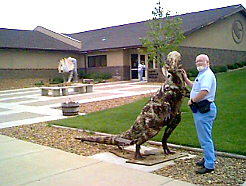 warm friendly one who wanted his
head scratched as the first Rebarbasaurus, for the
material it was made out of.
warm friendly one who wanted his
head scratched as the first Rebarbasaurus, for the
material it was made out of.
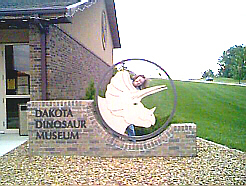 Laura, in the
meantime was consulting a fellow creature that
was with the entrance sign. As we entered, the
foyer was filled with pamphlets on various local
attractions, including a few on the museum. The
layout was great. The center room had a large
sand pit in the middle which displayed creatures
and fossils in a very attractive way.
Laura, in the
meantime was consulting a fellow creature that
was with the entrance sign. As we entered, the
foyer was filled with pamphlets on various local
attractions, including a few on the museum. The
layout was great. The center room had a large
sand pit in the middle which displayed creatures
and fossils in a very attractive way.
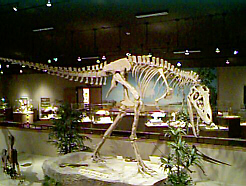 The center of
the pit was dominated by the fossil structure of an
Albertosaurus. The right side of the room housed
an extensive mineral and gem collection including
a room for fluorescent minerals. The left side
contained display cases of smaller fossils along
with other assorted objects of interest. Although
there are several models, 91 percent of the
exhibits are real, with 10 full scale dinosaurs.
The center of
the pit was dominated by the fossil structure of an
Albertosaurus. The right side of the room housed
an extensive mineral and gem collection including
a room for fluorescent minerals. The left side
contained display cases of smaller fossils along
with other assorted objects of interest. Although
there are several models, 91 percent of the
exhibits are real, with 10 full scale dinosaurs.
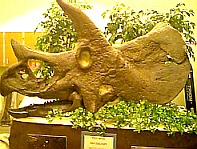 Located in a glassed fronted room at the rear of
the sandpit is the pride and joy of the museum.
Their own authentic Triceratops skull. It was
found not too far from the museum. Eric
explained how, after it was located, archeologists
slowly removed the ground around it, adding a
plaster substance as they went until the skull was
completely encased. It was then safely removed
without fear of breakage
Located in a glassed fronted room at the rear of
the sandpit is the pride and joy of the museum.
Their own authentic Triceratops skull. It was
found not too far from the museum. Eric
explained how, after it was located, archeologists
slowly removed the ground around it, adding a
plaster substance as they went until the skull was
completely encased. It was then safely removed
without fear of breakage
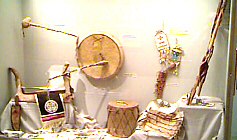 and brought to the
museum where it has been in the state of
restoration for sometime. It was just recently
freed from all it’s plaster. This one item makes
the trip worth while. In an adjoining room, are the artifacts of
people who grew up along the Yellowstone river
in Billings, including a most interesting
photograph display of the old cowboys taken by a
local photographer. The Crow and Sioux Indians
are represented in costume and tools, as is an
assortment of unrelated antiques and collectibles.
The museum is designed to peak the interest of
curious minds of any age.
and brought to the
museum where it has been in the state of
restoration for sometime. It was just recently
freed from all it’s plaster. This one item makes
the trip worth while. In an adjoining room, are the artifacts of
people who grew up along the Yellowstone river
in Billings, including a most interesting
photograph display of the old cowboys taken by a
local photographer. The Crow and Sioux Indians
are represented in costume and tools, as is an
assortment of unrelated antiques and collectibles.
The museum is designed to peak the interest of
curious minds of any age.
*** THE END ***
